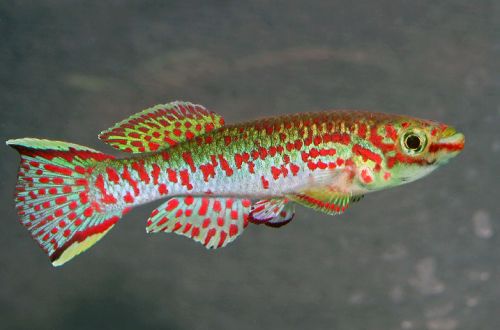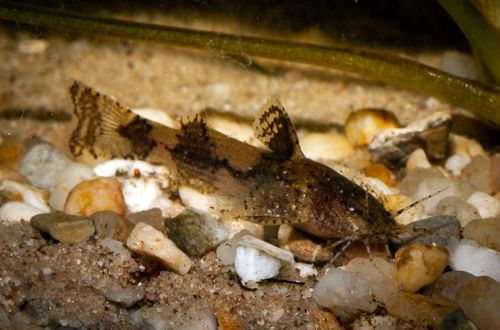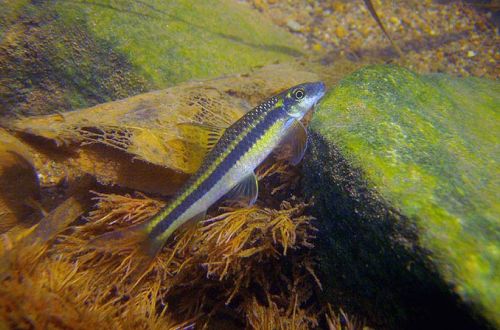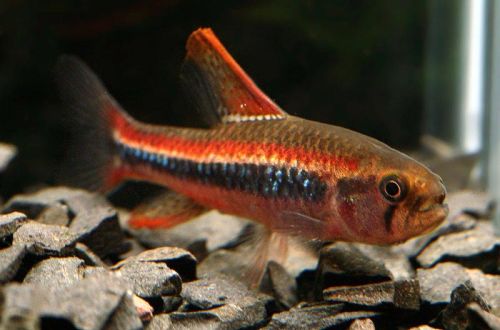
Afiosemion Gardner
Afiosemion Gardner or Fundulopanhax Gardner, scientific name Fundulopanchax gardneri, belongs to the family Nothobranchiidae. Bright beautiful fish, easy to keep and breed, peaceful in relation to other species. All this makes him an excellent candidate for a general aquarium, as well as for the role of the first pet of a novice aquarist.

Contents
Habitat
It originates from the territory of Nigeria and Cameroon (Africa), is found in the Niger and Benue river systems, as well as in coastal waters at the confluence of rivers and streams into the sea. The natural habitat covers a variety of habitats, from tropical rainforests to dry savannas, where it is not uncommon for rivers to completely dry up.
Brief information:
- The volume of the aquarium – from 60 liters.
- Temperature – 20-26°C
- Value pH — 6.0–7.5
- Water hardness – soft (1-10 dGH)
- Substrate type – any
- Lighting – any
- Brackish water – no
- Water movement is weak
- The size of the fish is 5–6 cm.
- Nutrition – any combined feed
- Temperament – peaceful
- Keeping a group in the ratio of one male and 3–4 females
Description
Adults reach a length of up to 6 cm. Males are somewhat larger than females and have more elongated fins. Body color differs between members of the same species and is determined by the region of origin or breeding form. The most popular fish with a bluish tint of steel or golden color. A characteristic feature for all forms are numerous red-brown specks and bright edging of the fins.
Food
They accept all types of dry, frozen and live food. In the daily diet, it is recommended to use various types of products, for example, flakes and granules with herbal supplements in combination with bloodworms, daphnia or brine shrimp. An excellent alternative can be specialized feeds for specific families of fish, which provide all the necessary components for normal growth and development.
Maintenance and care, arrangement of the aquarium
A group of 3-4 fish will need a tank with a volume of 60 liters or more. The design should provide for a large amount of aquatic vegetation, both floating on the surface and rooting, while maintaining open areas for swimming. Any substrate is selected based on the needs of plants. Various decorative elements are not of great importance and are placed at the discretion of the aquarist.
Please note that the aquarium must be equipped with a lid to prevent accidental jumping of the fish, and the equipment (primarily the filter) is adjusted in such a way as not to create excessive internal flow, which Afiosemion Gardner is not used to.
Otherwise, this is a very unpretentious species that does not require special personal care. To maintain optimal living conditions, it is enough to replace part of the water weekly (15–20% of the volume) with fresh water and regularly clean the soil from organic waste.
Behavior and Compatibility
Peaceful and friendly fish in relation to representatives of other non-aggressive species of similar size. However, intraspecific relationships are not so harmonious. Males are very belligerent towards each other and in a small aquarium they can arrange skirmishes. In addition, during the mating season, they show excessive attention to females, forcing them to seek shelter. Therefore, the best option is one male and 3-4 females.
Breeding / breeding
The unpredictability of the natural habitat, associated with frequent periods of drought, has led to the emergence of a special adaptive mechanism in these fish, namely, eggs, in the event of a drying up of the reservoir, are able to maintain their viability for more than a month, being under a layer of dried silt or a layer of plants.
In a home aquarium, roars will breed a couple of times a year. Spawning will require dense accumulations of undersized plants or mosses, or their artificial counterparts, among which eggs will be laid. Fertilized eggs should preferably be immediately transferred to a separate tank with identical water conditions to avoid being eaten by their own parents. The incubation period lasts from 14 to 21 days depending on the water temperature.
Fish diseases
Health problems arise only in case of injuries or when kept in unsuitable conditions, which depresses the immune system and, as a result, provokes the occurrence of any disease. In the event of the appearance of the first symptoms, first of all, it is necessary to check the water for the excess of certain indicators or the presence of dangerous concentrations of toxic substances (nitrites, nitrates, ammonium, etc.). If deviations are found, bring all values back to normal and only then proceed with treatment. Read more about symptoms and treatments in the Aquarium Fish Diseases section.





